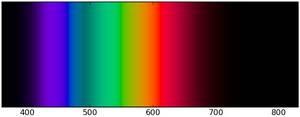What are Laser Wavelengths?
 |
Characteristic for many types of laser is, that they only emit single color light, also known as monochromatic light. Physically that means that the Laser only emits a single wavelenght. If the light is split into its spectral components using a prism, you will see sharp lines. This is also why these wavelengths are also called "laser lines". Lasers which emit only one wavelength are also called "single line lasers".
But there are also lasers which emit several different wavelenghts. These are called "multi line lasers".
In contrast to this the light of the sun, a light bulb or a candle always contains a mixture of many wavelenghts. When you look at the spectrum through a prism, you will not find single lines but a continuous spectrum.
Visible Laser Wavelengths
The following table contains the most often used visible laser wavelengths used for laser shows and the corresponding laser type.
- 676.4nm - Krypton Laser dark Red
- 671nm - DPSS Laser (dark-) Red
- 652nm - Laser Diodes used for reading/writing DVDs
- 647.1nm - Krypton Laser Red
- 635nm - Red Laser Diodes
- 632.8nm - Helium Neon Laser Rot
- 578.2nm - Copper Vapor Laser Yellow
- 577nm - OPSL Laser Yellow
- 568.2nm - Krypton Laser Yellow
- 532nm - DPSS Laser Green
- 530.9nm - Krypton Laser Green
- 528.7nm - Argon Laser Green
- 520nm - Green Laser Diodes
- 514.5nm - Argon Laser Green
- 510.6nm - Copper Vapor Laser Green
- 496.5nm - Argon Laser Green
- 488nm - Argon Laser Cyan
- 476.4nm - Argon Laser Blue
- 476.2nm - Krypton Laser Blue
- 473nm - DPSS Laser Blue
- 457.9nm - Argon Laser Violet
- 440nm - Nichia Violet Laser Diodes
- 413.1nm - Krypton Violet
- 405nm - Blu-Ray (Ultra-)Violet Laser Diodes




